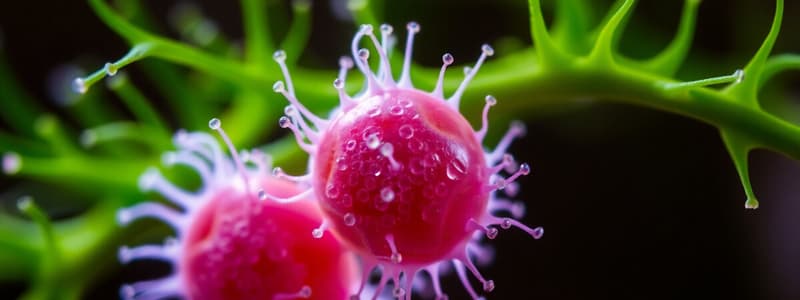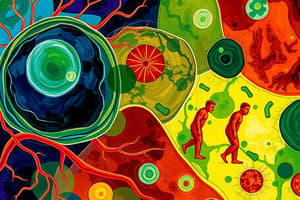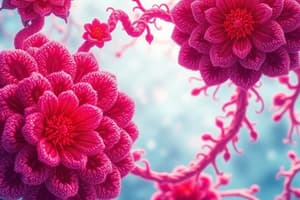Podcast
Questions and Answers
What are the primary building blocks of life?
What are the primary building blocks of life?
- Systems
- Cells (correct)
- Tissues
- Organs
Aerobic respiration occurs without oxygen.
Aerobic respiration occurs without oxygen.
False (B)
What process do plants use to convert sunlight into food?
What process do plants use to convert sunlight into food?
Photosynthesis
The process by which organisms compete for food, water, or space is called __________.
The process by which organisms compete for food, water, or space is called __________.
Match the following processes with their descriptions:
Match the following processes with their descriptions:
Which of the following best describes a habitat?
Which of the following best describes a habitat?
Extinction occurs when a species adapts to environmental changes.
Extinction occurs when a species adapts to environmental changes.
What is the function of ribosomes in a cell?
What is the function of ribosomes in a cell?
Flashcards
What is a cell?
What is a cell?
The basic unit of life. All living organisms are made up of one or more cells.
What is photosynthesis?
What is photosynthesis?
The process by which plants convert light energy into chemical energy (glucose).
What is respiration?
What is respiration?
The process by which organisms break down food to release energy. There are two types: aerobic (with oxygen) and anaerobic (without oxygen).
What is natural selection?
What is natural selection?
Signup and view all the flashcards
What is genetics?
What is genetics?
Signup and view all the flashcards
What is an ecosystem?
What is an ecosystem?
Signup and view all the flashcards
How does energy flow through an ecosystem?
How does energy flow through an ecosystem?
Signup and view all the flashcards
What is human impact on the environment?
What is human impact on the environment?
Signup and view all the flashcards
Study Notes
Cells
- Cells are the basic units of life.
- Cell parts include the nucleus (controls the cell), mitochondria (creates energy), and ribosomes (produce proteins).
- Body organization progresses from cells to tissues, organs, and systems.
- Vaccines help prevent diseases.
Organisms
- Habitats are the locations where organisms live.
- Ecosystems involve communities of organisms working together.
- Energy flows from the sun to plants, then animals, and finally decomposers.
- Nutrient cycles, like the carbon cycle, involve the exchange of carbon dioxide between plants and animals.
- Organisms are grouped based on similarities, forming classifications like mammals and reptiles.
Processes
- Photosynthesis is how plants use sunlight to create glucose (food).
- Respiration is the process of releasing energy.
- Aerobic respiration requires oxygen.
- Anaerobic respiration occurs without oxygen and produces less energy.
Metabolism
- Digestion breaks down food into usable nutrients.
- Transport moves substances within and outside of cells, like osmosis moving water.
Evolution
- Natural selection describes the "survival of the fittest."
- Genetics means that traits are passed from parents to offspring via DNA.
- Cell division includes mitosis (for growth and repair) and meiosis (for creating reproductive cells).
Environment Interactions
- Plants grow toward light (tropism).
- Senses like sight, hearing, and touch allow organisms to interact with the world around them.
- Hormones regulate growth and energy use.
Interactions Between Organisms
- Pathogens are disease-causing microorganisms.
- Predators and prey depict the relationship where animals hunt and are hunted.
- Food chains illustrate who eats whom in an ecosystem.
- Competition happens when organisms vie for limited resources.
- Extinction occurs when a species vanishes due to environmental changes.
Humans and the Environment
- Human activities impact the environment through things like deforestation and pollution.
- Conservation involves protecting and preserving the environment, including its species.
- Solutions to environmental problems include recycling, using sustainable energy, and minimizing waste.
- Homeostasis maintains a stable internal environment, such as body temperature.
Studying That Suits You
Use AI to generate personalized quizzes and flashcards to suit your learning preferences.
Related Documents
Description
This quiz covers essential concepts in biology from cellular structure to ecosystems. Learn about cell functions, energy flow in ecosystems, and the processes of photosynthesis and respiration. Test your knowledge on how organisms interact with their environment and each other.




